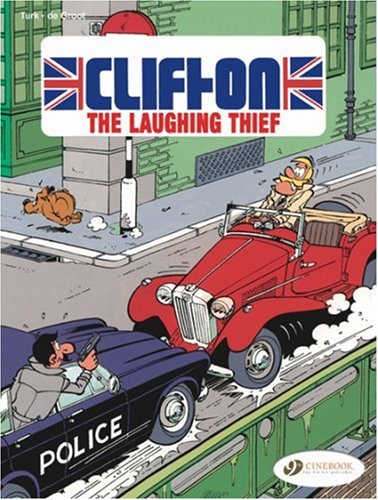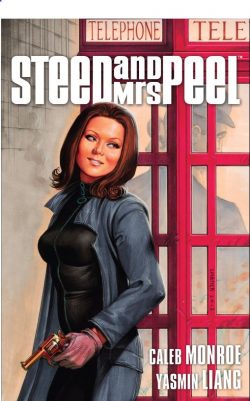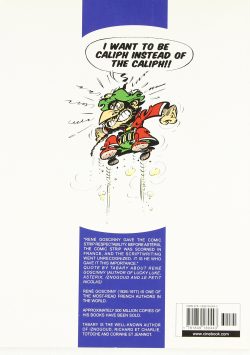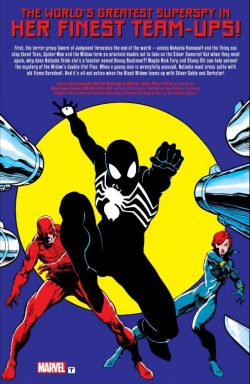
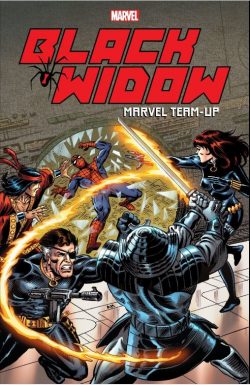
By Chris Claremont, Tom DeFalco, Marv Wolfman, Roger McKenzie, Bill Mantlo, Priest, Fabian Nicieza, Robert Campanella, Dan Slott, Bob Brown, Sal Buscema, Will Meugniot, Ron Frenz & Greg LaRocque, Rob Liefeld, Larry Alexander & Dwayne Turner & various (DC Comics)
ISBN: 978-1-3029- (TPB)
The concept of team-ups – an established star pairing or battling (usually both) with new or less well-selling company characters – has been with us since the earliest days of comics, but making the temporary alliance a key selling point really took hold with DC’s The Brave and the Bold before being taken up by their biggest competitor.
Marvel Team-Up was the second regular Spider-Man title, launching at the end of 1971. It went from strength to strength, heralding expansion and spawning a second collaborative vehicle in Marvel Two-In-One (with the Fantastic Four‘s strong man The Thing), both offering regular venues for uncomplicated action romps in addition to the House of Ideas’ complex sub-plot fare.
However, even in the infinite Marvel Multiverse, certain stars shine more brightly than others and some characters turn up in team-ups more often than others…
In recent years, carefully curated themed collections from the back-catalogue have served to initiate new readers intrigued by Marvel’s Movie and TV endeavours, and this engaging trade paperback/eBook compilation gathers a selection of potent pairings starring superspy The Black Widow, taken from MTIO #10; Marvel Team-Up #57, 82-85, 98, 140-141 and short tales from fortnightly anthology Marvel Comics Presents #53, 70 and 93: collectively spanning July 1975 – January 1992.
Natasha Romanoff (sometimes Natalia Romanova) is a Soviet Russian spy who came in from the cold and stuck around to become one of Marvel’s major female stars. She started life as a svelte, sultry honey-trap during the early “Commie-busting†days, targeting Tony Stark and battling Iron Man in her debut (Tales of Suspense #52, April, 1964).
She was subsequently redesigned as a torrid tights-&-tech super-villain before defecting to the USA, falling for an assortment of superheroes – including Hawkeye and Daredevil – before finally enlisting as an agent of S.H.I.E.L.D., setting up as a freelance do-gooder and joining/occasionally leading the Avengers.
Throughout her career she was always ultra-efficient, coldly competent, deadly dangerous and yet somehow cursed to bring doom and disaster to her paramours. As her backstory evolved, it was revealed Natasha had undergone experimental processes which enhanced her physical capabilities and lengthened her lifespan, as well as assorted psychological procedures which had messed up her mind and memories…
Traditionally a minor fan favourite, the Widow only really hit the big time after the Marvel Movie franchise was established, but for us unregenerate comics-addicts her print escapades have always offered a cool, sinister frisson of delight.
The multi-player mayhem opens with Marvel Two-In-One #10 by Chris Claremont, Bob Brown & Klaus Janson: a slice of inspired espionage action-intrigue with Ben Grimm joining the Widow’s war against suicidal terrorist Agamemnon who plans to detonate the planet’s biggest nuke at the bottom of the ocean in a blockbuster 007-styled thriller ‘Is This the Way the World Ends?’.
With artists Sal Buscema & Dave Hunt, Claremont continues defining the Widow’s ways in Marvel Team-Up #57 (May 1977) starting a complex extended thriller embroiling Spider-Man in a devious and deadly espionage plot which begins ‘When Slays the Silver Samurai!’ After being saved from a lethal ambush by Natasha and implausibly holding up a collapsing building, Spidey takes reluctant possession of a strange statuette but soon forgets all about it
The scheme comes to fruition in MTU #82 (June 1979) when Claremont, Sal B & Steve Leialoha craft a 4-part, multi-operative conclusion starting with Spider-Man saving Natasha from street thugs. In ‘No Way to Treat a Lady’ the lethal superspy has escaped capture and torture by retreating into a timid, ineffectual cover personality, and the Arachnid must keep “Nancy Rushman†alive until he learns how and why. The job gets even harder after S.H.E.I.L.D.’s Strike Forcecome mercilessly gunning for her…
The first (white) Nick Fury joins the fray in ‘Slaughter on 10th Avenue!’ capturing Nancy before discovering – when Spidey steals her back – that his entire organisation has been taken over by hidden mastermind Viper and her super hench-thugs Silver Samurai and Boomerang…
‘Catch a Falling Hero’ (MTU #84) reveals the purpose of that long-forgotten statuette, as Viper targets Washington DC and President Jimmy Carter. Meanwhile Spider-Man and the slowly recovering Nancy infiltrate the compromised flying fortress Helicarrier and Fury calls in British operative Shang Chi, Master of Kung Fu for a distracting frontal assault, culminating in all-out war above the Capitol and the closest of close shave conclusions for all concerned in ‘The Woman Who Never Was!’
A far simpler motive reunited the widow and the webspinner when separate cases overlapped in MTU #98 (October 1980, in an untitled tale by Marv Wolfman, Roger McKenzie, Will Meugniot & Bruce Patterson). Here dockside gunrunners and ambitious mobsters draw the heroes into a clash with The Owl, after which we jump to April 1983 and MTU #140 for the first part of a morally trying dilemma posed by Bill Mantlo, Tom DeFalco, Ron Frenz & Mike Esposito with ‘Where Were You …When the Lights Went Out?’
A city-wide blackout provokes riots and looting and Spider-Man is on scene when a skeevy pawnshop owner is shot dead. The next day, lawyer Matt Murdock is appointed to defend gangbanger teen Juan Santiago who is indicted for the murder. Press photographer Peter Parker is also in attendance, and both know the kid is not guilty. As Spider-Man resolves to investigate further, Daredevil‘s old flame Natasha Romanoff volunteers to fact-find for the overworked attorney. When investigations overlap a street gang are exposed as behind the incident, but the new murder suspect triggers a deadly car chase and hostage situation before being apprehended.
Frustratingly, although responsible for much of the tragedy on that night, he quickly proves to also be innocent of the pawnbrokers’ death…
This yarn takes place at the beginning of Marvel’s Secret Wars event and pauses for Spidey to go to The Beyonder‘s Battleworld; fight lots and come back with his all-black Symbiote uniform, so it’s a much-altered Spider-Man who joins Daredevil and the Widow in obtaining ‘Blind Justice’ in #141 (DeFalco, Jim Owsley AKA Priest, Greg LaRoque & Esposito) as the heroes uncover mob connections and a trail to Kingpin Wilson Fisk, the real killer and the true nature of the kid they’ve been defending…
The team-ups conclude with a selection from twice monthly rotating anthology Marvel Comics Presents, starting with ‘Heads I Win, Tails You Lose’: a jurisdictional clash between Natasha and mercenary antihero Silver Sable from #53 (July 1990) by Fabian Nicieza, Rob Liefeld & Bob Wiacek, and continuing with ‘One into Three Won’t Go!’ (#70, February 1991 by Robert Campanella, Larry Alexander, Jack Abel & Al Milgrom) as the Widow and fellow former Champion Darkstar battle the hyper-irradiated Red Guardian when her master The Presence orders her to capture them for his harem.
Their valiant resistance inspires Tania Belinskaya to overthrow her own mental shackles and transform into new hero Starlight before this collection closes with an early outing for superstar scripter Dan Slott & artist Dwayne Turner who end the ultra-espionage alliances with a ‘Split Seconds’ reunion for the Widow and Daredevil from MCP #93, battling Hydra goons and deactivating deadly booby traps in a midtown building.
The book’s bonus section offers original art from Meugniot & Patterson; Frenz & Esposito and cover-art by Ed Hannigan & Klaus Janson, plus data pages of Black Widow and her weapons and gear from the Official Handbook of the Marvel Universe and a painted cover by Al Milgrom.
These stories may vary in quality, but all stem from an honest drive to entertain and most fans will find little to complain about. Although primarily a tome for casual or new readers – who will have a blast – there’s also a ton of nostalgic delights and patented Marvel mayhem to be had by veteran viewers, and surely that’s reason enough to add this titanic tome to your secret stash of great reads…
© 2020 MARVEL





